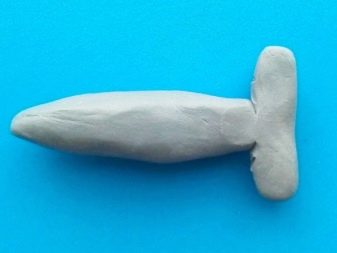Methods for sculpting sharks from plasticine

You need to know how to sculpt sharks from plasticine even just in order to explain to children how to mold a hammerhead shark step by step. It is equally important to figure out, however, how to make a tiger shark in stages. Some people may be interested in how to properly sculpt a great white shark.
Simple option
The formidable inhabitants of the seas and oceans have riveted the attention of people for a long time. Plasticine predators can be very interesting for preschool children.
The modeling material should be white, black and blue. It is better to take more of it, so as not to run into a disadvantage. Of the tools, only the stack is needed.

The work begins with the laying of the body of the toothy fish. The blue lump is rolled up in a "sausage" manner. One edge should be relatively wide, the other should be made narrower. Plasticine torn from a narrow edge is used to make the tail fin. It is very good if there is still 3 balls left for sculpting other fins. It is advisable to keep a photo with a sample ready. Two fins are attached on the sides, and one is “planted” on the back. Later:
- prepare a "sausage" and flatten it;
- attach this element to the belly of the predator;
- decorate the fins on the sides with medium-sized white triangles;
- form a mouth (preparation of teeth is done additionally using a stack);
- the eyes are developed by creating a base of white plasticine, to which small pupils are attached.

How to make a hammerhead shark?
Children aged 7-8 years have more information about the world around them than preschoolers. And the abstract shark figure is no longer very interesting for them. But you can offer them a more unusual creature - a hammerhead shark. They take a gray mass for her. The body is shaped like an ordinary sea fish, but the head will outwardly imitate a house hammer. The abdominal part should be covered with a white pad proportional to the size of the predator. Fins and a tail will help complete the look.




The eyes will be located at the edges of the elongated scary head. By varying their performance, one can express emotions: interest or surprise.
Rough gills do not need to be shaped with a knife: a regular pencil helps to scratch them. Large gill slits are not needed: it is sufficient if they are clearly visible.
This is where all the work ends.




How else can you blind?
Consider the step-by-step sculpting of other types of sharks.
Tiger
This predator is also made from gray plasticine. Basic sequence of steps:
- divide the mass into 2 parts;
- the smaller part is left for the tail and fin forms;
- the body is molded from the main part of plasticine;
- one edge of the "sausage" is cut with a stack to make something like a mouth;
- prepare the tail like the most common fish;
- form the rest of the fins (not forgetting the one on top);
- eyes are created from beads;
- sharply sharp white teeth are laid inside the mouth.






White
Main steps:
- rolling a lump and dividing it into 2 fragments;
- stretching a large "sausage";
- stretching the tail with your hands;
- finalizing the tail to an expressive and clear shape with additional movements;
- giving the whole figure an elongated shape;
- flattening and flattening of the head;
- a slit of a wide mouth and a small jaw abduction downward;
- pinching to give additional relief;
- gluing a strip of white cardboard to the belly;
- pink tongue insert;
- reworking the mouth for complete authenticity;
- attachment of fins.

For information on how to mold a plasticine shark, see the next video.








